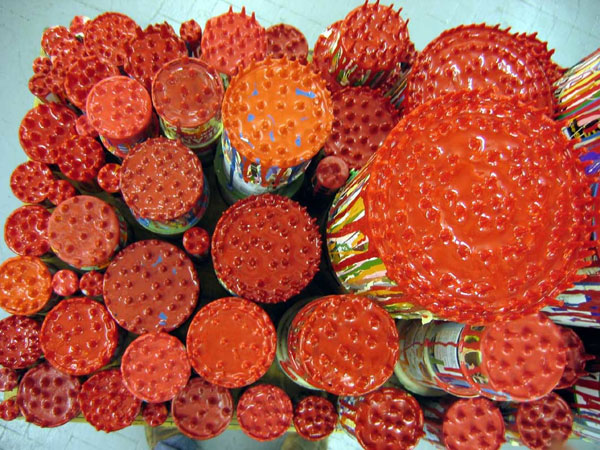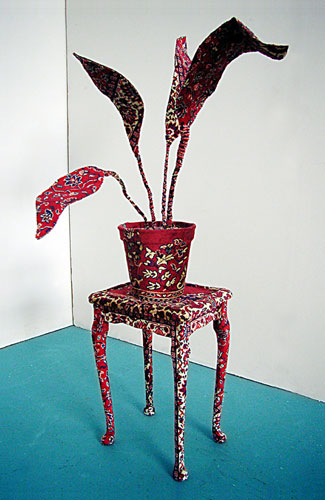| EXHIBITIONS NEWS PRESS ABOUT US CONTACT |
|||||
| REPRESENTED ARTISTS | BERTILLE BAK | GWENAEL BELANGER | DEXTER DYMOKE | ANTTI LAITINEN | |
| MARKO MAETAMM | YUDI NOOR | OLIVER PIETSCH | KIM RUGG | ||
| BETTINA SAMSON | SINTA WERNER | ||||
THE
JOY
Curated by Kate Street
Louise Colbourne | Gary Colclough | Andrew Ekins | Annabel Elgar |Debbie
Lawson | Brian Reed | Kate Street | Kate Terry
7 SEPTEMBER - 7 OCTOBER 2007
NETTIE HORN is proud to present The Joy, a show that brings together a collection of artists who relish sensuality, innuendo, the tongue-in-cheek, and in some cases, the outright perverse in creative practice. In the exhibition, these interests manifest themselves through the use of materiality, suggestive meaning and our inclination to humanise inanimate objects. In regards to our relationship with nature, the artists realise our tendency to assimilate successes, failings, or impotencies with fellow creatures, in order to make sense of our most basic instincts. Although there is a playfulness that prevails throughout the exhibition, there is something more important which underlies the show – the acknowledgement that despite our vulnerabilities as human beings, we still hope for fulfilment in other beings or objects, no matter how profound or trivial.

Andrew Ekins, Rest
and Play, 2005 , Oil, Acrylic, Wax, Tins, and table, 183 x 61
x 127 cm
Louise Colbourne’s video installations contain elements of sculpture, moving image and dance that combine classical forms with contemporary mediums. Duet (2006) is a 16mm film animation of two large white minimalist forms that appear to be dancing a tango together. By assimilating Modernist objects and images with emotive possibilities, the work allows for new and challenging possibilities that contain subtle irreverence and humor.
Gary Colclough’s paintings depict lone men caught in the act of contemplation. In a state of undress, their gaze is drawn away from the viewer, suggesting that the individuals in question are looking for answers or gratification, but perhaps finding neither. As the paintings allude to the promise of fulfilment, they also carry the weight of its absence.
Andrew Ekins’ paintings navigate a complex dialogue between the sublime, the abject, and contemporary notions of beauty. The physicality of the work references domestic comfort by various forms of bedding supplanting the place of canvas, whilst simultaneously conveying a sense of the bodily and the visceral. His paintings manifest themselves as material expressions of existence - trace elements of presence and influence.
Annabel Elgar's work maps out a set of possibilities that dampen any comfort in the idyllic backdrops that the photographs propose. Staged encounters, with heightened foregrounds and a voyeuristic intimacy, are swiftly usurped by the notion that as narratives they are in fact fictional. In the assumed drama that is being witnessed, the prerogative is the exposure of vulnerability in its various forms.
 Debbie Lawson, Collar and Cuffs, 2007, mixed media, 120x60x60cm |
Debbie Lawson’s hybrid sculptures and inlaid wooden panels take you on a journey through the psychological landscape of the domestic interior, where the very walls and floors are charged with desire, while humdrum objects quietly smoulder in the heat of sublimated emotion. Like a picaresque tale, the work gradually unfolds to reveal strange truths about the world through a series of misadventures. Brian Reed’s text pieces manifest themselves from an interest in the doublespeak of corporate and political vocabulary. They take on the recognizable appearance of the command statements used in advertising that undermine our self-esteem, exploit our vulnerabilities and make us believe in the false hope of fulfillment promised within a brand's ideology. Kate
Street’s series Bird in the Hand (2007) is a
response to the proverb and the presumption that it suggests:
that something achieved and attained has more worth than a
simple desire. As human beings, it is in our nature to analyse,
dissect and compare our attainments with others’. We
need to pull apart the components, and search for the root
of our wants and needs - sometimes having little understanding
of what that actually is. This idea of misunderstood desire
and aspiration, together with the search for meaning, plays
a key part in her work. |
For The Joy, artist duo Kate Terry & Gary Colclough have designed new work entitled, Pandamonium (2007), a papered wall depicting a mammalian orgy of pandas. Inspired by the classical designs of William Morris and traditional Chinese wallpaper designs, the pattern of pandas emerge from the background pallet of muted tones. The wallpaper represents a kind of celebration of the suppressed reality behind our fascination with these creatures - their reluctance to do the ‘animal thing’ and our collective interest in seeing it happen.
© NETTIE HORN